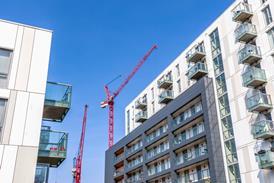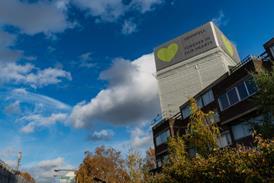The CLT ban could damage investor confidence in modern methods of construction, says Thomas Lane

When the government announced details of its combustible cladding ban at the end of last year, the cross-laminated timber (CLT) industry’s worst fears were confirmed. The consultation on the ban, announced by the government last summer, stated a preference to permit only materials with a Class A1 or A2 rating in the external walls of residential buildings over 18m high, equivalent to six storeys. At the time architect Anthony Thistleton, whose practice Waugh Thistleton has done so much pioneering work with CLT, warned that a ban could spell the end of the industry in the UK.
Nevertheless the ban went ahead and the CLT sector is trying to adapt. Some have been remarkably sanguine about the ban, saying the majority of residential buildings constructed from CLT came under the 18m ceiling and therefore wouldn’t be affected. For buildings over 18m a hybrid approach could be adopted with CLT used for the internal walls and floors and a non-combustible material, probably steel, for the external structure.
The ban may only affect a small number of buildings but it’s a case of negative perceptions. A material deemed to be dangerous for use in buildings over six storeys is hardly going to inspire confidence in those considering buying a fifth-floor flat in an apartment block built from CLT. The insurance industry has become very risk-averse post-Grenfell and could baulk at insuring CLT buildings or make the premiums prohibitively expensive.
The most damaging aspect of this ban is the impact it could have on innovation more generally, with potentially negative implications for modern methods of construction. CLT has gained rapid traction as panels can be factory-cut to size and erected quickly on site; its light weight means the size of foundations can be reduced, and the carbon footprint is much lower than concrete. Crucially, the use of CLT makes economic sense which is why companies such as Legal & General and Swan Housing Group have invested in their own factories. Swan says it will now have to find other solutions to build its planned high-rise homes.
The CLT industry says the material is safe because a protective char forms on the surface of the panels in a fire, which limits the spread. But the Concrete Centre points to research that indicates CLT panels can sometimes delaminate in a fire, exposing fresh wood. Tony Jones, the principal structural engineer of the Concrete Centre, describes a situation where CLT can be used for the internal walls and floors of a high-rise building but not the walls as “bizarre”. He has a point. If CLT does significantly contribute to the spread of fire, then it is only right that the material is only used in situations where people can get out safely.
The only way to establish the fire performance of CLT with any certainty is full-scale testing. This isn’t without precedent. In September 2000, BRE set fire to a six-storey timber-framed building in an old airship hangar at its Cardington Research Centre which unexpectedly reignited inside the cavity wall because cavity barriers were missing, allowing the fire to spread unseen. This provided valuable lessons for the industry and fire brigades faced with cavity fires in multi-storey timber-framed buildings. A similar test, perhaps funded jointly by the industry and the government, would establish the fire performance of CLT and all the interdependent building elements needed to ensure good performance. Although the results would come too late for high-rise CLT buildings, it could bolster confidence and encourage others to invest in CLT for low-rise buildings or alternatively demonstrate that investment should be focused on other construction methods – robustly tested of course.
















1 Readers' comment